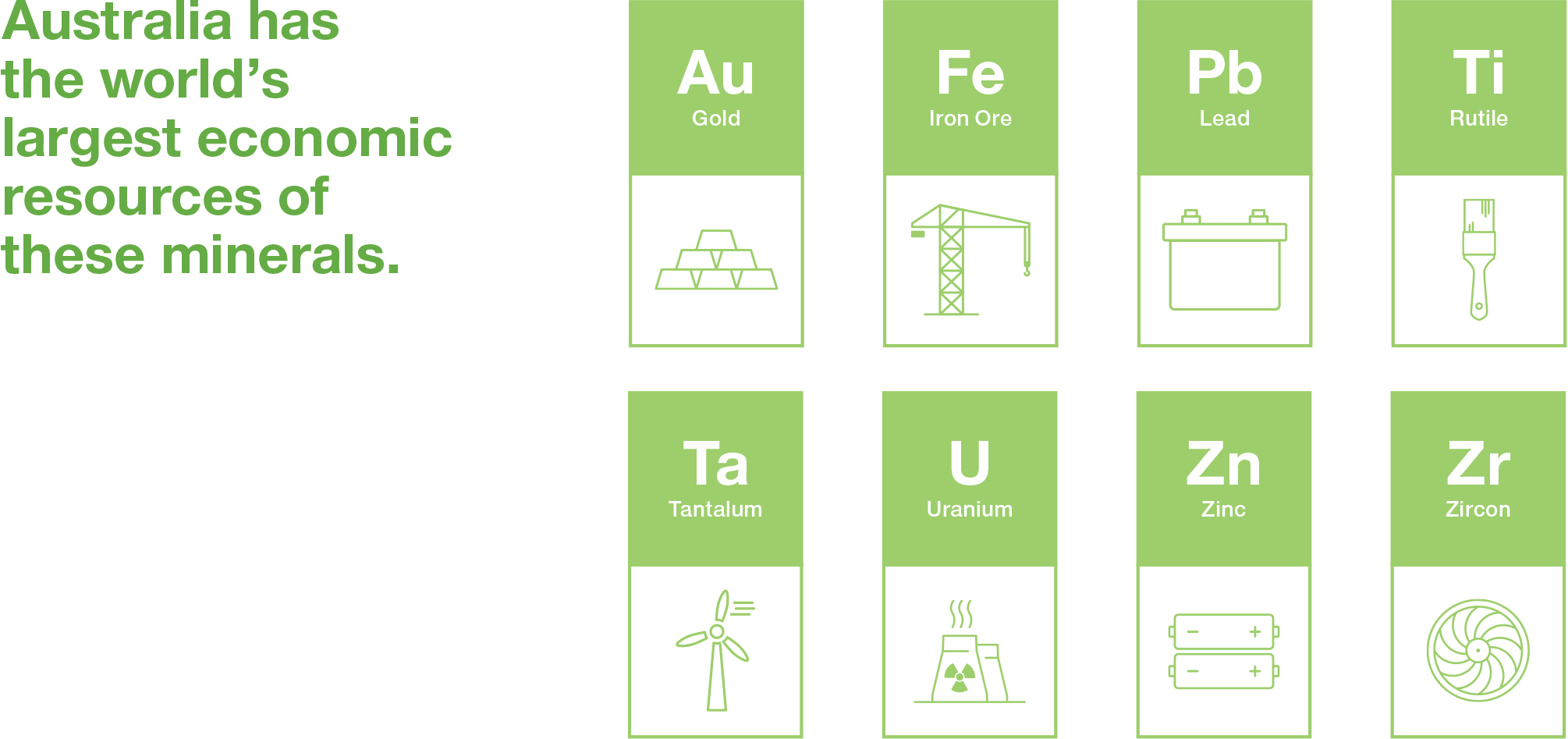AIMR 2019 at a Glance
Notes: Economic Demonstrated Resources and production rankings as at 31 December 2018. Changes are from 31 December 2017 to 31 December 2018. Resource life for each mineral commodity is calculated by dividing the inventory (EDR) by production. The resulting ratio is a snapshot in time that can only be used for general impressions because it is an average and it assumes (1) that production rates in the future will remain the same as those used in the calculation, (2) deposits deemed economic/uneconomic remain so in the future and (3) that depleted resources are never replaced.
Acronyms, Abbreviations and Symbols
| kg | kilogram |
| t | tonne |
| kt | kilotonne (thousand tonnes) |
| Mt | million tonnes |
| L | litre |
| GL | gigalitre |
| c | carat |
| Mc | million carats |
| oz | ounce |
| lb | pound |
| km | kilometre |
| % | per cent |
| tpa | tonnes per annum |
| ktpa | kilotonnes per annum |
| Mtpa | million tonnes per annum |
| MTU | metric tonne unit |
| ppm | parts per million |
| PGE | platinum group elements |
| REE | rare earth elements |
| REO | rare earth oxides |
| SOP | sulphate of potash |
| AIMR | Australia’s Identified Mineral Resources |
| ASX | Australian Securities Exchange |
| CRIRSCO | Committee for Mineral Reserves International Reporting Standards |
| JORC | Joint Ore Reserve Committee |
| JORC Code | Joint Ore Reserve Committee Australasian Code for Reporting of Exploration Results, Mineral Resources and Ore Reserves |
| IAEA | International Atomic Energy Agency |
| OECD/NEA | Organisation for Economic Cooperation and Development/Nuclear Energy Agency |
| USA | United States of America |
| USGS | United States Geological Survey |
| AEDR | Accessible Economic Demonstrated Resources |
| EDR | Economic Demonstrated Resources |
| RAR | Reasonably Assured Resources |
| $ | dollar (Australian) |
| US$ | United States of America dollar |
| AG | Aktiengesellschaft (joint-stock company) |
| Co | Company |
| Corp | Corporation |
| Inc | Incorporated |
| Ltd | Limited |
| PLC | Public Limited Company |
| PTY | Proprietary |
JORC Code
The following terminology and definitions are used by the Joint Ore Reserves Committee (JORC) Code for reporting of Mineral Resources and Ore Reserves (2012 Edition). A full copy of the JORC Code can be found at www.jorc.org.
Mineral Resource: A ‘Mineral Resource’ is a concentration or occurrence of solid material of economic interest in or on the Earth’s crust in such form, grade (or quality), and quantity that there are reasonable prospects for eventual economic extraction. The location, quantity, grade (or quality), continuity and other geological characteristics of a Mineral Resource are known, estimated or interpreted from specific geological evidence and knowledge, including sampling. Mineral Resources are sub-divided, in order of increasing geological confidence, into Inferred, Indicated and Measured categories.
Inferred Mineral Resource: An ‘Inferred Mineral Resource’ is that part of a Mineral Resource for which quantity and grade (or quality) are estimated on the basis of limited geological evidence and sampling. Geological evidence is sufficient to imply but not verify geological and grade (or quality) continuity. It is based on exploration, sampling and testing information gathered through appropriate techniques from locations such as outcrops, trenches, pits, workings and drill holes. An Inferred Mineral Resource has a lower level of confidence than that applying to an Indicated Mineral Resource and must not be converted to an Ore Reserve. It is reasonably expected that the majority of Inferred Mineral Resources could be upgraded to Indicated Mineral Resources with continued exploration.
Indicated Mineral Resource: An ‘Indicated Mineral Resource’ is that part of a Mineral Resource for which quantity, grade (or quality), densities, shape and physical characteristics are estimated with sufficient confidence to allow the application of Modifying Factors in sufficient detail to support mine planning and evaluation of the economic viability of the deposit. Geological evidence is derived from adequately detailed and reliable exploration, sampling and testing gathered through appropriate techniques from locations such as outcrops, trenches, pits, workings and drill holes, and is sufficient to assume geological and grade (or quality) continuity between points of observation where data and samples are gathered. An Indicated Mineral Resource has a lower level of confidence than that applying to a Measured Mineral Resource and may only be converted to a Probable Ore Reserve.
Measured Resource: A ‘Measured Mineral Resource’ is that part of a Mineral Resource for which quantity, grade (or quality), densities, shape, and physical characteristics are estimated with confidence sufficient to allow the application of Modifying Factors to support detailed mine planning and final evaluation of the economic viability of the deposit. Geological evidence is derived from detailed and reliable exploration, sampling and testing gathered through appropriate techniques from locations such as outcrops, trenches, pits, workings and drill holes, and is sufficient to confirm geological and grade (or quality) continuity between points of observation where data and samples are gathered. A Measured Mineral Resource has a higher level of confidence than that applying to either an Indicated Mineral Resource or an Inferred Mineral Resource. It may be converted to a Proved Ore Reserve or under certain circumstances to a Probable Ore Reserve.
Modifying Factors: ‘Modifying Factors’ are considerations used to convert Mineral Resources to Ore Reserves. These include, but are not restricted to, mining, processing, metallurgical, infrastructure, economic, marketing, legal, environmental, social and governmental factors.
Ore Reserve: An ‘Ore Reserve’ is the economically mineable part of a Measured and/or Indicated Mineral Resource. It includes diluting materials and allowances for losses, which may occur when the material is mined or extracted and is defined by studies at Pre-Feasibility or Feasibility level as appropriate that include application of Modifying Factors. Such studies demonstrate that, at the time of reporting, extraction could reasonably be justified.
Probable Ore Reserve: A ‘Probable Ore Reserve’ is the economically mineable part of an Indicated, and in some circumstances, a Measured Mineral Resource. The confidence in the Modifying Factors applying to a Probable Ore Reserve is lower than that applying to a Proved Ore Reserve.
Proved Ore Reserve: A ‘Proved Ore Reserve’ is the economically mineable part of a Measured Mineral Resource. A Proved Ore Reserve implies a high degree of confidence in the Modifying Factors.








